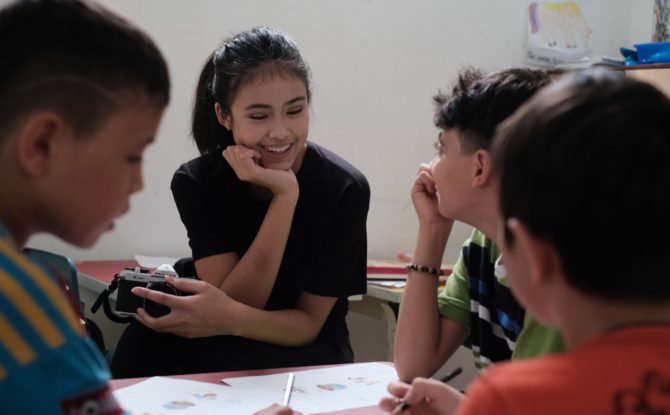
An Interview with Katrina Wardhana (Founder of Art for Refuge) Compassion Above All
 “What’s challenging is not about becoming a woman who leads, but more about becoming a youth that is able to leadâ€
That was the answer that I received from Katrina, during our virtual interview when I asked her about the challenges and obstacles she’s been facing as a woman-leader. Being a leader at the age of 18 and having to run a social initiative program, while still having to pursue her degree abroad was never an easy job. Katrina puts herself in each of those outlets, and one of her keys to keeping all things in balance is compassion.
For some of us, oftentimes compassion could be such a challenging and heavy word. Let’s be honest here. Giving, showing affection, being empathetic, being aware and immersed in our surroundings wasn’t something that is easy to do. There’s our ego that plays alongside our hearts when we’re about to leap on to a more compassionate decision. But during my interview with Katrina, she told me about her journey of developing Art for Refuge (AFR), a social initiative program focusing on providing art classes for refugees, where compassion plays one of the most important roles in the process.
Katrina Wardhana
Katrina is currently an art history student at Brown University. Growing up, art has always been her passion and she used to invest a lot of her time drawing. Although she hasn’t been doing that much of it lately, she still believes that art, in any form, delivers a greater and deeper meaning, that leads her into taking a major in both art history and visual art.
During her years in high school, she volunteered on a program held by Roshan Learning Center, where she got the chance to meet the refugee kids for the first time.
“My role at that time was to teach them English at first, but then I started to think as to why they didn’t receive other classes such as art. Art for me personally has always been a therapeutic process, and I see that it could also be a way to help the kids to relieve their anxiety being away from a place called home.â€
From this simple thought and experience, she decided to come up with an initiative to provide art classes for the refugee kids. From that moment on, the journey of AFR began.
Art for Refuge in a Glance
At first, what Katrina did was just merely sharing her experience and her process during her volunteering in Roshan Learning Center through her Instagram. From a marketing point of view, what she did was remarkably spot-on.
“I saw Instagram as a platform that incorporates visuals and storytelling. By knowing your audience, you will know when and how to deliver your stories and instill emotional sentiments to it, make people more engaged in what you’re trying to deliver.â€
As sympathy grew, AFR was established around 2016. Since then, AFR has been providing various art classes, from painting to photography, from embroidery to poetry. The refugees are more engaged than ever. As refugees, having no citizenship in their protective country means
The education it provides surely has given these refugees hope for the future, that when someday they’re being placed to their final destination, they could always find ways to make a living.
Challenges
Growing up, she stated that the possibility for women to lead was never to be questioned, especially in this era. Both her mother and her sister were experienced in leading other social initiative programs. She sees that when women walk hand in hand, it is very possible to conquer the challenges they have before them.
However, if she needs to be completely honest, the challenge she’s facing is more about being a young leader than it is being a woman leader. One of the challenges faced by young leaders is that sometimes people are selling themselves too low. We’re seen as someone that is inexperienced, especially when it comes to being a leader, be it in a project, community, organization, let alone a company.
Throughout her experience, she’s faced challenges when it comes to logistics and having to reach out to the right people at the right moment.
“I was in this conference where I get to explain and tell people more about the cause of refugees. One of the questions thrown at me was “Why should we invest in refugees, when we should be focusing more on our local community first?â€. The thing about this cause is that this is too overlooked. It’s a problem faced by so many countries, yet so few are taking parts in it. I aim to make better living for these people.â€
Furthermore, Katrina told me about one of her struggles when she created an art exhibition in The National Gallery (Galeri Nasional) for these refugees, that on a contrary are not Indonesian. It was a struggle itself to convince people to believe in the cause and to actually take part in it.
Along the way, there are certain key values Katrina is trying to deliver, to make sure that she truly becomes the leader she envisions herself to be, and it takes grit to do all this. 3 key values Katrina reminds us to have as a young leader are;
- Be creative in your ways
Find ways to make people believe in what you do, be it by utilizing creative campaigns, storytelling, partnering with other organizations or companies, and find ways to make it work.
- Show a lot of compassion, understanding, and open mindedness
To be able to come up with something, be aware of the problems that your surrounding is facing. For Katrina there’s no way to do so without compassion, understanding, and open mindedness.
In her case, having to deal with refugees isn’t an easy reception for everyone. Not everyone is being used to deal with this certain issue. But when you have compassion towards the cause or the problem, you’ll definitely figure out your own ways.
- Have a lot of patience along the process
There’s no such thing as a free lunch. Every of your process takes time, it sometimes even requires you to sacrifice a thing or two. But when you’re letting yourself immersed into the process, it will definitely pay off.
Messages for the Future Young Leaders
“When you’re not sure where to start, try to identify first the cause that you are really passionate about. When you know what it is, oftentimes we’re scared to put ourselves out there and to reach out to people that would actually be a great help for us. Don’t do that. It is a long battle but no one will do it for you. So be brave and take the risk to fully represent the cause you believe in.
Throughout the process, be empathetic on how to make people understand. Find ways to tap into your market in the right way. Infographics are nice, but when it comes to a cause, there’s always a story that you could tell through visuals and words. Remember that you’re not doing it for yourself, you’re doing it for others for a greater purpose.â€
This powerful message is what I try to remind myself everyday, that there should always be greater purpose in what we do as a leader.
